Dr. Michael Shaw is an acclaimed sculptor whith many solo and group exhibitions to his name. As well as having won prizes for his work he has a PHD in sculpture and makes inspiring and thought provoking work. He is 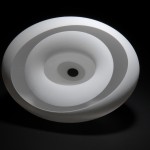 currently an AHRC research fellow at Loughborough University where he is exploring rapid manufacturing and digital design. Loughborough University by the way may not sound familiar to you now, but they do cutting edge work in rapid manufacturing and as far as we are concerned is one of the most relevant and exciting places to be right now. You can check out Michael’s website and work here, his 3D printed work here or his faculty page here.
currently an AHRC research fellow at Loughborough University where he is exploring rapid manufacturing and digital design. Loughborough University by the way may not sound familiar to you now, but they do cutting edge work in rapid manufacturing and as far as we are concerned is one of the most relevant and exciting places to be right now. You can check out Michael’s website and work here, his 3D printed work here or his faculty page here.
Suffice it to say that we are very proud that Michael, or rather Dr. Michael Shaw, is a Shapeways member and one of our best customers to boot. We’re also glad he took the time to answer some questions we had for him.
Why do you use Maya?
Maya, despite being horrendously
complicated, is quite user friendly because the basic means for
changing geometry are easily visible and there is a simple logic to
things like the attributes editor and the history capability.
However, I wouldn’t like to have to learn it again, that’s not to
say I’m anyway near mastering it, but that I have no desire to go
right back to the beginning! It is in some ways like Pandora’s box,
once you open it all sorts of stuff comes out; for example how
animation and particle systems can be used to modulate geometry. So
it’s is an incredibly rich tool, but at the end of the day it’s
just a tool; a really complicated pencil. What’s key is the
geometry you develop with it, and without any kind of real world
underlying philosophy it’s likely to be quite vacuous.
continued below.
So Maya is a really complicated
tool. What would your ideal 3D modelling tool look like?
Maya is undoubtedly complicated, but
I’m definitely not saying that’s necessarily a bad thing. It’s
tough to learn, but the rewards are great. I guess an ideal 3D
software would incorporate the best aspects of the Maya, Rhino3D and
so on. I’ve tried things like Solidworks and heavy duty CAD but
found them wholly alien. Personally, I favour modelling and working
with NURBS, so anything that parallels the way I might make something
in the real world would be good.
Rodin said that, “he chose a
block of marble and chopped off what he didn’t need” in a 3d
modelling package one starts with a blank screen, does this change
sculpture itself?
I don’t really think so; because it
is inevitable one will either consciously or subconsciously import
one’s re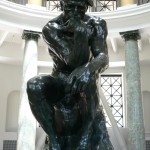 al world philosophy into the virtual environment. That
al world philosophy into the virtual environment. That
said, there are aspects of CAD software which have precipitated new
forms in my practice that I simply wouldn’t have imagined, or been
able to hand craft. For example, in CAD one can effect subtle
distortions to the whole of a form whilst maintaining its gestalt, or
in other words maintain the sense of its whole be that circular
elliptical or whatever whilst twisting or bending along some axis.
This for me is a powerful and extremely desirable attribute
Does working with 3D software mean
that you approach a sculpture differently?
In some ways, yes and in some ways no.
Most of the sculptures I make in the ‘real world’ have been cast
from constructed moulds or constructed in some way, so I don’t
really model materials such as clay for example. Virtually, my
approach is fairly similar; it’s a kind of construction often
starting with line rather than solids in order to create sinusoidal
cylinders. I am definitely infatuated with the awesome potential of
deformers like bend and twist and their effects when combined;
likewise lattice deformers. One of the great things about CAM for the
sculptor is the copy and paste function, which means it’s possible
to try an almost endless variety of forms without committing to the
time consuming and expensive process of fabrication. I contend this
encourages a playfulness and experimental exploration which can
sometimes go missing under the duress of the physical grind of making
things by hand.
You seem fascinated by distortion or
changes in a shape. When did altering of shapes, this ‘endless
variety of forms’ begin to influence and inspire you? 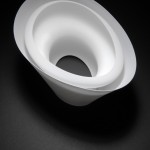
I’ve always been interested in
distorting shapes, however prior to Rapid Prototyping this often involved merely
slicing bits off an existing form or squashing them somehow when
curing in the mould, whereas CAD/CAM has completely opened up a whole
new range of possibilities. It is no exaggeration to suggest is has
been a revelation that has revolutionised my practice.
Do rapid manufacturing materials
change your process?
Often Rapid Prototyping is a means to quickly
fabricate a model which can then be rescaled up to something larger,
so in this case it functions as a means to an ends. Other times the
Rapid Prototyping object is the final artefact. I don’t envisage not making ‘real
world’ sculptures and I think a symbiotic relationship will
continue to exist in my practice for the foreseeable future whereby
one medium informs the other and vice versa. I like the white SLS
nylon(White, Strong & Flexible), but only when the form is so thin light can almost pass
through it, but the ideal RP materials would be the transparent ones
if only they were really UV resistant.
So is process or the end result
the most important to you?
Process, technique, call it what you
will, is simply a means to an ends for me; the only thing that
matters is the outcome. What defines the quality of the outcome is
the dynamism of the geometry, and form generation 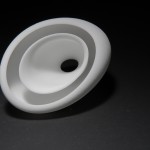 is the central
is the central
tenant of sculpting in my opinion. I would argue that it is the
primary concern of the sculptor because in selecting materials,
colours and surface finishes one operates as a conductor, whereas in
establishing geometry the sculptor is solely responsible. Rapid Prototyping and CAD
seem to have enormous potential in extending the possible vocabulary
of three dimensional forms.
What are the limitations and
advantages of rapid manufacturing?
The limits of Rapid Prototyping are inevitably the
cost and the build envelope of the machines. The former can be
mitigated somewhat by creating hollow geometries with thin walls or
caged or perforated structures; whereas the latter is definitely a
restriction for me given my focus on singular sculptural forms means
part by part construction is out. The primary advantages of Rapid Prototyping are
that you get what you design and that the complexity of the geometry
bears no consequence on the possibility to manufacture. In other
words, 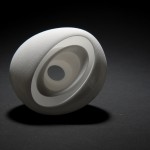 it doesn’t matter how complex the form is in terms of
it doesn’t matter how complex the form is in terms of
overhangs, subtle or complex distortions or forms within one another
the machine just prints it layer by layer. Sometimes I fear that the
outcome can be a little too antiseptic and that the imperfect touch
of the human is missing, on the other hand imperfection and
distortion can be built into the virtual geometry if so desired or
one can just accept the austere perfection as its quality and work
with it. One is also limited by the visual aesthetics of the
materials currently available for use. Real pungent vibrant colour
would be a welcome development, rather than the slightly washed out
pastels that the Z-corp machines produce in my opinion.
What do you mean by, that 3D printed
work is “too antiseptic and that the imperfect touch of the
human is missing”? Is it like Muslim artists in bygone days
making beautiful carpets but leaving in one intentional error to
demonstrate that only God is perfect?
I’ve always aspired to make ‘perfect’
objects by hand, but never really been able to achieve it, now RP has
enabled me to produce certain forms whose geometry is so consistent
that they might be considered to be ‘perfect’; but having seen
the results I’m not sure it’s really what I want. You finally get
what you always wanted and end up disappointed! On the other hand,
models straight out of the machine invariably have evidence of the
strata by strata manufacture; the layering remains and testifies to
how they were made, so 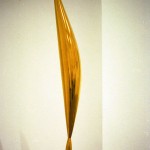 this might be considered an imperfection in
this might be considered an imperfection in
itself. I quite value the resulting lines because they function as
contour lines that simultaneously are and describe the form: and
similar linear qualities have been present in a lot of my previous
sculptures.
Anyway perfection is really a kind of
abstract notion or philosophical stance. The example you give has a
lot of parallels with the Japanese aesthetic notion Wabi-Sabi,
which favours imperfection over perfection. I have an empathy with
this way of thinking. For example, even in sculptures by Brancusi
such as Bird in Space which in photographs appear to be
‘perfect’, there are often deviations in the geometry or pitted
marks in their surfaces.
Is the Rapid Manufacturing process too clinical to
you?
Well, it certainly removes production
out of the worlds of chance and happenstance; often in real world
production errors can occur and these can prompt new developments in
terms of form or technique. However with the actual outputting of Rapid Prototyping
objects this does not happen simply because the machine faithfully
prints the data it is given. However, unexpected occurrences can also
emerge in the modelling of virtual geometry so to some extent the
unexpected is still present and intuition can play a role in shaping
work in the CAD/CAM arena.
Does a smudge from the artist’s
hand, a mistake somehow make a work more human? But, would the work
not be more perfect without the smudge?
There’s a lot to be said for the
signs and errors of the human hand. It has something to do with a
quite primal need to mark things with our own signature in some way I
think. Somehow there needs to be a bit of dirt under the fingernail
for me – for instance it’s the grain of sand in the oyster that
produces the pearl….!



The notion that there is a ‘so consistant geometry’ that might render ‘perfection’ of form is a curious desire, coming as it does from a sculptural empiricist.
However the enterview is informative, challenging and poetic even. There are loose ends and interogative dark spaces enough for the debate to continue a while longer.
The issue of an autonomous form and the ‘archetypal dream’, for example.
Gestalt indeed.
For all Maya lovers out there, did you know that we have a dedicated tutorial on how to best use Maya and Shapeways together? http://www.shapeways.com/blog/archives/105-Using-Maya-and-Shapeways-for-3D-printing.html